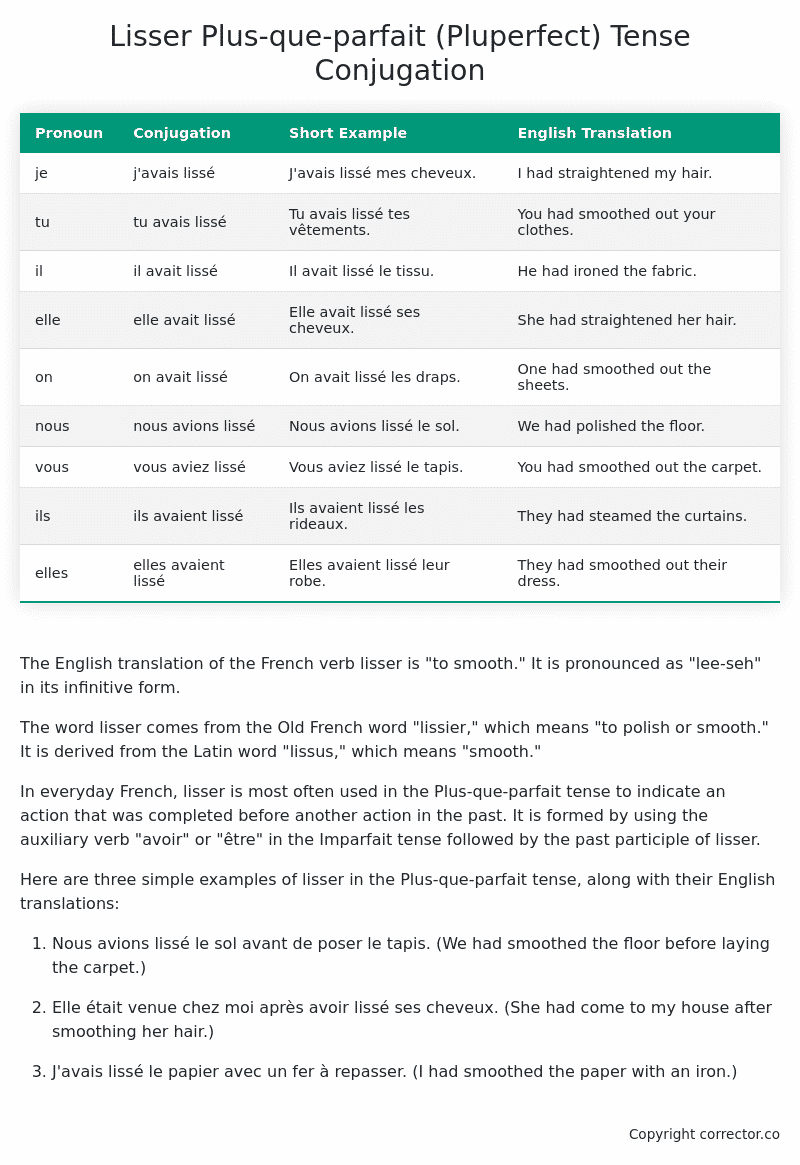Plus-que-parfait (Pluperfect) Tense Conjugation of the French Verb lisser
Introduction to the verb lisser
The English translation of the French verb lisser is “to smooth.” It is pronounced as “lee-seh” in its infinitive form.
The word lisser comes from the Old French word “lissier,” which means “to polish or smooth.” It is derived from the Latin word “lissus,” which means “smooth.”
In everyday French, lisser is most often used in the Plus-que-parfait tense to indicate an action that was completed before another action in the past. It is formed by using the auxiliary verb “avoir” or “être” in the Imparfait tense followed by the past participle of lisser.
Here are three simple examples of lisser in the Plus-que-parfait tense, along with their English translations:
-
Nous avions lissé le sol avant de poser le tapis. (We had smoothed the floor before laying the carpet.)
-
Elle était venue chez moi après avoir lissé ses cheveux. (She had come to my house after smoothing her hair.)
-
J’avais lissé le papier avec un fer à repasser. (I had smoothed the paper with an iron.)
Table of the Plus-que-parfait (Pluperfect) Tense Conjugation of lisser
| Pronoun | Conjugation | Short Example | English Translation |
|---|---|---|---|
| je | j’avais lissé | J’avais lissé mes cheveux. | I had straightened my hair. |
| tu | tu avais lissé | Tu avais lissé tes vêtements. | You had smoothed out your clothes. |
| il | il avait lissé | Il avait lissé le tissu. | He had ironed the fabric. |
| elle | elle avait lissé | Elle avait lissé ses cheveux. | She had straightened her hair. |
| on | on avait lissé | On avait lissé les draps. | One had smoothed out the sheets. |
| nous | nous avions lissé | Nous avions lissé le sol. | We had polished the floor. |
| vous | vous aviez lissé | Vous aviez lissé le tapis. | You had smoothed out the carpet. |
| ils | ils avaient lissé | Ils avaient lissé les rideaux. | They had steamed the curtains. |
| elles | elles avaient lissé | Elles avaient lissé leur robe. | They had smoothed out their dress. |
Other Conjugations for Lisser.
Le Present (Present Tense) Conjugation of the French Verb lisser
Imparfait (Imperfect) Tense Conjugation of the French Verb lisser
Passé Simple (Simple Past) Tense Conjugation of the French Verb lisser
Passé Composé (Present Perfect) Tense Conjugation of the French Verb lisser
Futur Simple (Simple Future) Tense Conjugation of the French Verb lisser
Futur Proche (Near Future) Tense Conjugation of the French Verb lisser
Plus-que-parfait (Pluperfect) Tense Conjugation of the French Verb lisser (this article)
Passé Antérieur (Past Anterior) Tense Conjugation of the French Verb lisser
Futur Antérieur (Future Anterior) Tense Conjugation of the French Verb lisser
Subjonctif Présent (Subjunctive Present) Tense Conjugation of the French Verb lisser
Subjonctif Passé (Subjunctive Past) Tense Conjugation of the French Verb lisser
Subjonctif Imparfait (Subjunctive Imperfect) Tense Conjugation of the French Verb lisser
Subjonctif Plus-que-parfait (Subjunctive Pluperfect) Tense Conjugation of the French Verb lisser
Conditionnel Présent (Conditional Present) Tense Conjugation of the French Verb lisser
Conditionnel Passé (Conditional Past) Tense Conjugation of the French Verb lisser
L’impératif Présent (Imperative Present) Tense Conjugation of the French Verb lisser
L’infinitif Présent (Infinitive Present) Tense Conjugation of the French Verb lisser
Struggling with French verbs or the language in general? Why not use our free French Grammar Checker – no registration required!
Get a FREE Download Study Sheet of this Conjugation 🔥
Simply right click the image below, click “save image” and get your free reference for the lisser Plus-que-parfait tense conjugation!

Lisser – About the French Plus-que-parfait (Pluperfect) Tense
Tense Formation
Common everyday usage patterns
Sequencing of past events
Background information
Hypothetical or reported speech
Interactions with other tenses
Summary
I hope you enjoyed this article on the verb lisser. Still in a learning mood? Check out another TOTALLY random French verb conjugation!


